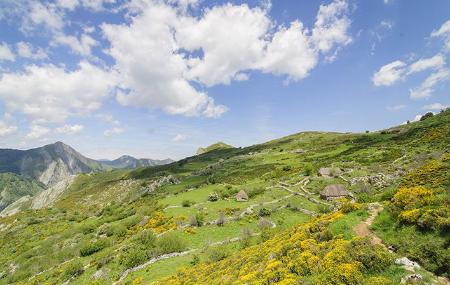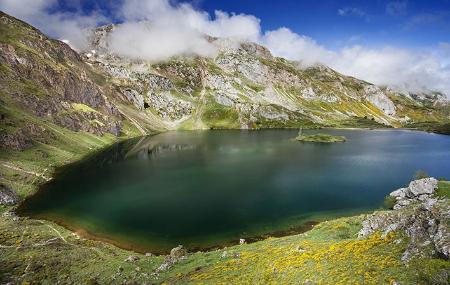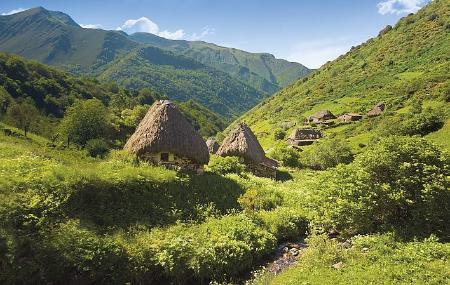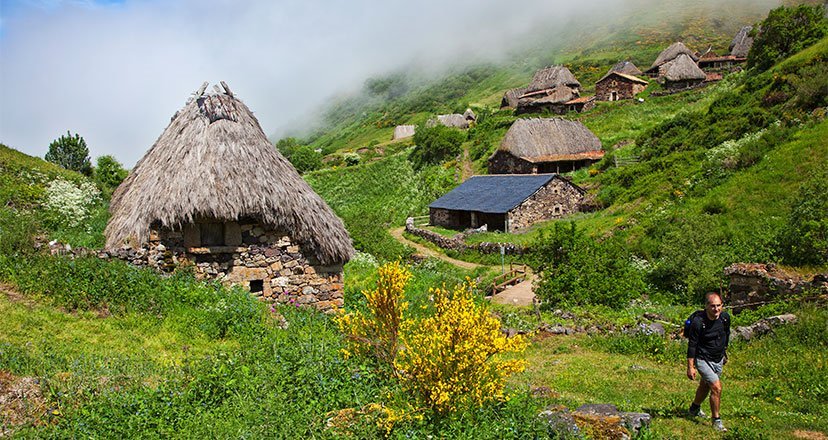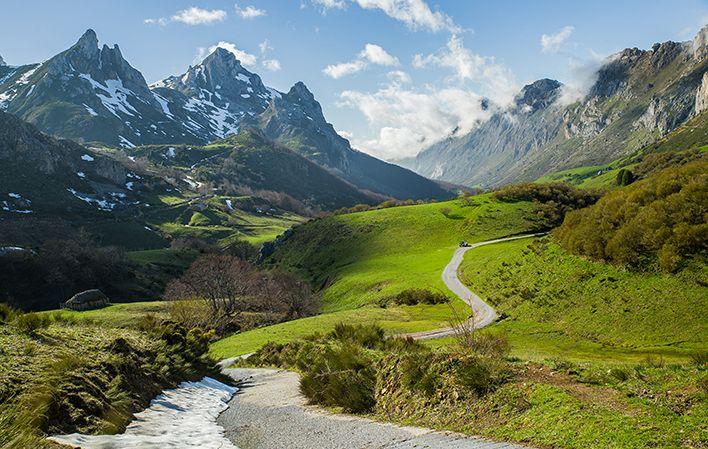
- Title Somiedo Asturias Centre
- Extension Extension: 283 km 2
- Open to the public Open to the public: All year round.
- Maximum elevation Maximum elevation: 2,194 m on Pico Cornón.
- Somiedo Natural Park Reception and Interpretation Centre.
- Ecomuseum of Somiedo (Caunedo) and Casas de Teito (Veigas).
- Routes: Lago del Valle, Lagos de Saliencia, Las Brañas de la Pornacal and Brañavieja, Ruta de Sousas, Ruta del Cornón.
- Protected areas in the Park: Natural Monument Conjunto Lacustre de Somiedo.
- Flora and fauna observation: Bear Interpretative Paths, Castro Interpretative Path, accessible path of Pola de Somiedo.
- Brañas: Mumián, La Pornacal, La Peral, Sousas.
- Code GOOD PRACTICES.
- ACTIVITIES NOT ALLOWED:
- Causing a nuisance to fauna or damaging flora.
- Free camping, caravans or other mobile shelters (except bivouacking in ZUG, ZUA and ZAM).
- Water activities such as canyoning, white water rafting, rafting, etc. in the rivers of the Natural Park.
- Sporting activities with motor vehicles.
The Somiedo Natural Park was declared a Biosphere Reserve in 2000. It extends over five valleys: Saliencia, Valle del Lago, Puerto y Pola de Somiedo, Perlunes and Pigüeña, and its five rivers with which they share a name, covering an area of 283 square kilometres.
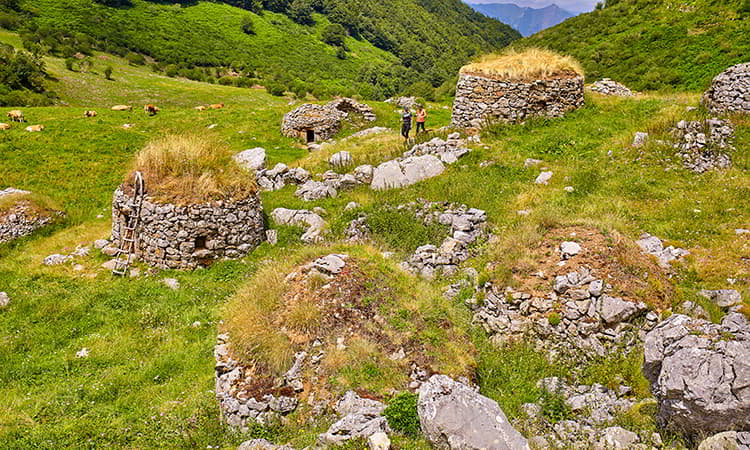
Man has been able to understand the nature of the Park and it has returned its care, remaining almost unchanged over the centuries, being, even today, an example of coexistence and complete integration.
Of its landscape, the beauty of the lakes, located to the south of the council of Somiedo, at the top of the mountain ranges that separate Somiedo from León, stands out: the three small lakes of Saliencia; the Lago del Valle, with its characteristic islet, and which is the largest lake in Asturias, with an average radius of 280 metres and an average depth of 10 metres, although in some areas it reaches 50 metres; and the hidden Lagunas de El Páramo, between the valleys of the rivers Somiedo and Pigüeña.
It is one of the most rugged landscapes in Asturias, with gradients ranging from 400 to 2,200 metres. The geological features of the area are of great geological value, due to the great variety of materials: limestone, siliceous, sandstone..., which give rise to spectacular karst forms. Valleys sprinkled with minerals such as iron, arsenic deposits, mercury, lead, marble and granite. A space of contrasts between peaks and depressions, which show the mark of the tectonic movements suffered in its numerous thrusts, faults and folds.
Throughout its entire length, there are brañas with fertile pastures where you can see, not without difficulty, the famous "cabanas" of teito de escoba: stone huts with roofs made of broom and broom and pine trees, used by the vaqueiros de alzada and the livestock farmers of the mountains as a refuge. There are currently more than 500 huts distributed throughout the park. In the surrounding area, cattle still move around in search of the best pastures.
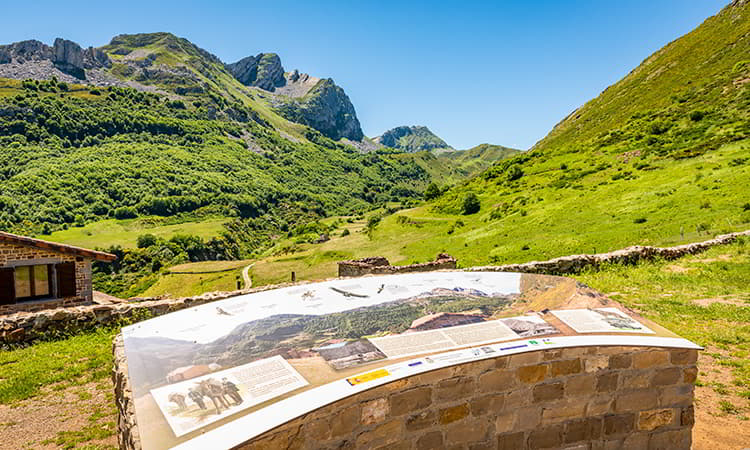
The average annual temperatures in the area are around 9°C in the valley bottoms, while at higher altitudes this parameter drops by about 0.5°C per 100 metres. Snowfalls are frequent in the winter months above 1,200 metres; the coldest months are January and February, and the warmest months are July, August and September, with a considerable difference in temperature between the two periods, a typical feature of the continental climate.
It was the first of the Principality's areas to be declared a Natural Park. This decision was intended to achieve, among other objectives, the conservation of its ecosystems, habitats and species; to improve the life of its inhabitants, and to maintain the ethnographic heritage and the agricultural and livestock activity compatible with its conservation. The passing of the years has shown that these objectives have been achieved.
In the Somiedo Natural Park, dogs must be under the effective control of their owner (preferably on a leash), except for herd guarding dogs, hunting dogs and guide dogs.

Plant life
A large part of the area is covered by different types of forests, hills, brañas, pastures on the lower slopes and farmland in perfect harmony with the surroundings. The main wooded area is in the Saliencia valley, on the slopes of the Coto and in the Pigüeña valley. Basically, these are deciduous forests, except for some enclaves with holm oak groves in the lower areas.
The largest forest formations are beech forests, followed by oak, holm oak and birch groves.
Different types of azonal vegetation and peat bogs of great interest can also be found here. A characteristic feature of these forests is the considerable density of shrubs, which indicates minimal degradation of the environment.
It is also a place of abundant and exquisite flora, represented by the bearberry, the gammon, the yellow and blue matalobos and the wind grass. The typical flower of Somiedo, Centaurium Somedanum, is also remarkable.
The quality of the waters of the rivers gives way to the formation of surprising riparian forests, with a privileged ecosystem between the aquatic and terrestrial forests.
Wildlife
The Park is home to more than 100 species of birds: the blackbird, the yellow wagtail, the kingfisher... some live on the banks of the rivers, dotted with the sound of trout, which are very abundant in this area; and on the peaks and high areas of Somiedo, the capercaillie and the golden eagle stand out.
All the large mammals of the Cordillera can be found in Somiedo, with the brown bear being particularly important. Predators such as the wolf and the fox, and other carnivores such as the otter, the badger or the wild cat share the territory, up to the lower areas of the rivers, with capercaillies and about 20 species of amphibians and reptiles, among which the salamander, the Iberian newt and the Seoane's viper stand out.
The Somiedo Natural Park, which is located in the southern sector of Asturias, on the border between the central and western mountain areas, includes the council of Somiedo.
Biosphere Reserve and European Charter for Sustainable Tourism.
Reception and Interpretation
Interpretation Centre of the
Natural Park of Somiedo
33840. La Pola Somiedo
985 763 758
Timetables, activities and free workshops in the RENA (Asturias Natural Network) centres.

